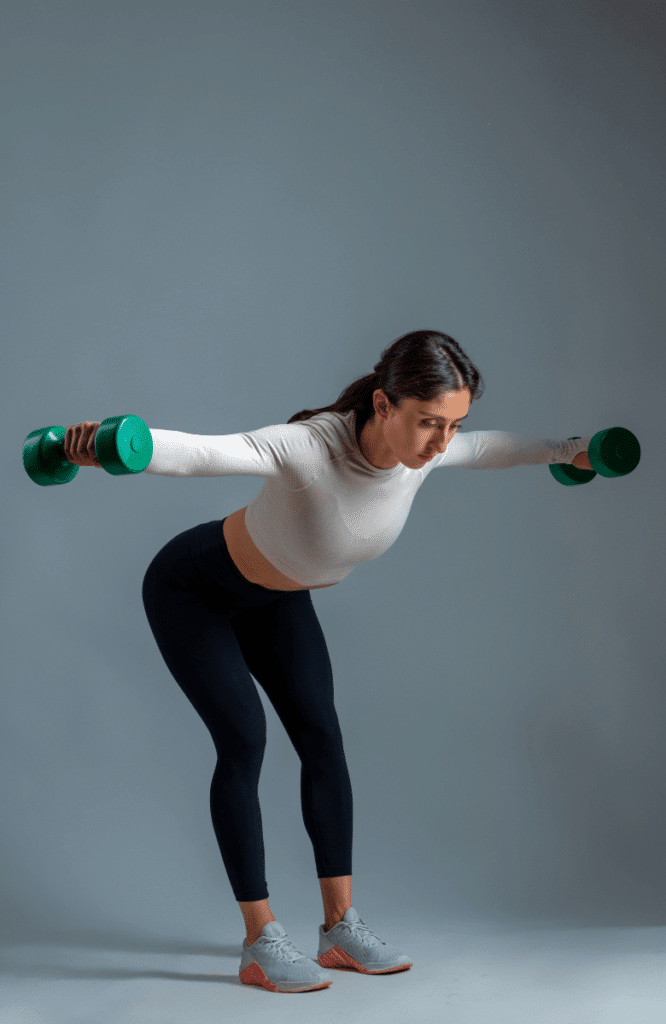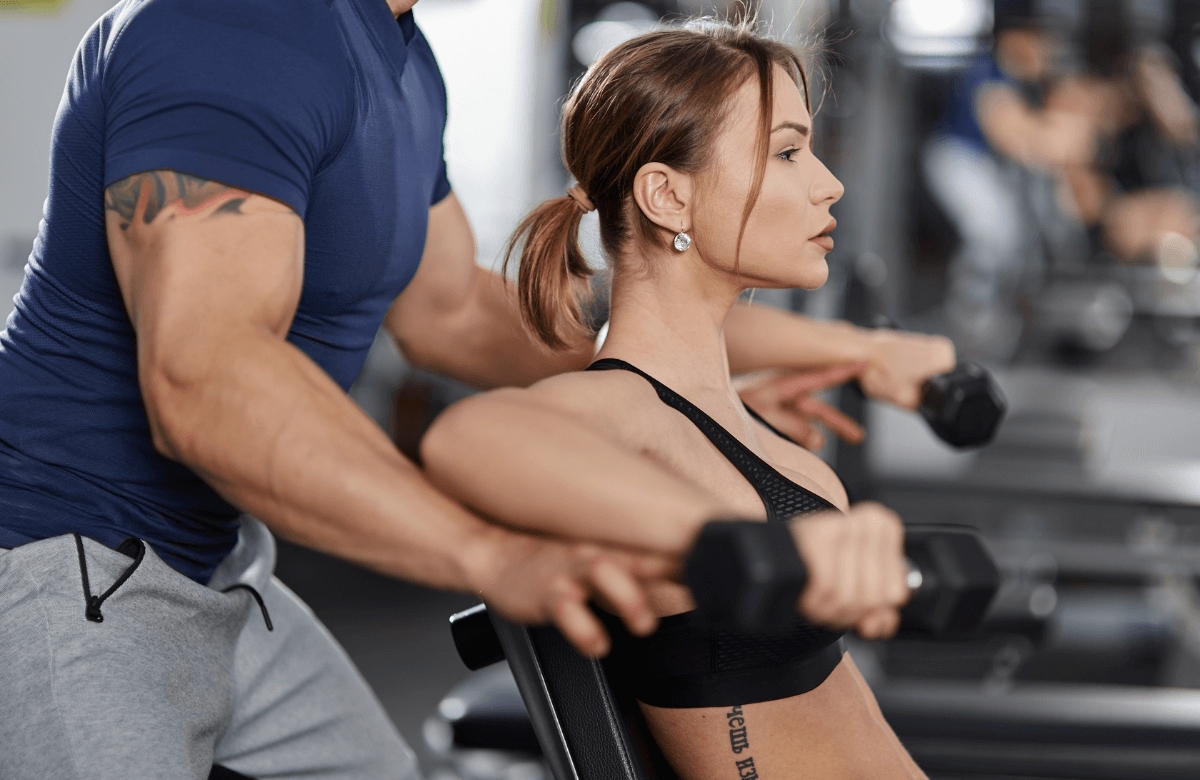Do you want to get strong posterior deltoids? The rear delt fly is a great compound exercise that you can implement into your shoulder workout routine.
In this article, we are going to tell you how to do rear delt fly, the benefits, and the muscles worked by this wonderful exercise. Also, we’ll cover rear delt fly variations, such as the cable rear delt fly and dumbbell rear delt fly. Let’s get started.
Jump to:
What Is a Rear Delt Fly?
The rear delt fly, also known as the bent-over dumbbell reverse fly or the rear delt raise, is an exercise that can help you build your upper back muscles. This weight training exercise can be performed with dumbbells, a cable machine, a fly machine, or a pec deck machine.
Muscles Worked by the Rear Delt Fly
The purpose of this compound exercise is to work your rear deltoid muscles or posterior deltoids that are on the backside of your shoulders. It also targets the middle trapezius muscle and rhomboids.

Benefits of the Rear Delt Fly
Here are the benefits of the rear delt fly:
- Proper posture;
- Improved shoulder stability;
- Stronger shoulders;
- Muscle growth. Defined, and bigger the posterior deltoids, rhomboid muscle, and middle trapezius;
- Prevent muscle weaknesses;
- Prevent muscle imbalances;
- Prevent risk of injury.
How To Do Rear Delt Fly
The starting position: Sit on the end of a bench and put your legs out in front of you. What you’re going to do is to bend forward. You’re going to rest your chest right on your thigh. And that keeps your body in the proper position.
You grab a pair of dumbbells and you’re going to start right at the very bottom. You can let the dumbbells touch each other. You are going to do the same thing as standing. Bring the dumbbells up. Pause. And control it back down.
Our tips:
- Focus on keeping your chest on your thigh. But don’t press too much on it;
- Keep shoulder blades in a stable position to maximize tension on your rear delts;
- Try to avoid cheating and using momentum. Don’t move your body to help with the range of motion.

Common Mistakes
Here are common rear delt fly mistakes:
- Squeezing shoulder blades together;
- Shifting tension to the traps.
Variations of the Rear Delt Fly
1. Cable Rear Delt Fly
What you’re going to do is to set up two cables that are all the way up. You’re basically just going to replicate the movement of Weapon X and come out down by the sides of your body.
This is going to heavily recruit your posterior chain, obviously not just the posterior deltoids. You’re hitting your shoulders, traps, and lats as well. But the rear deltoids are going to be recruited heavily during this rear delt exercise.
Single-Arm Rear Delt Cable Fly
Here is the proper form of this cable rear delt fly variation.
Firstly, it’s okay if your elbows are a little bit higher or lower on one side than the other. Because this isolation exercise gives you more flexibility to adjust things perfectly based on your body and structure.
For a 1-arm rear delt fly, all you need to do is find that arm position that is ideal for your structure to get your arm behind your body. Set the cable height up at an angle where it tracks pretty much straight through the upper arm through the entire motion.
In terms of body position due to the way that the resistance works on this cable versus a free weight like a dumbbell, you’ll find it more or less challenging in different positions of the range of motion based upon where you stand.
If you stepped back from the cable station, the movement will be significantly more challenging. And as you step in closer, the movement becomes easier to perform.
2. Dumbbell Rear Delt Fly
Here are the dumbbell rear delt fly variations:
1. Flat Bench Rear Delt Fly
You’re lying face down on a flat bench for this rear delt fly. It makes this a much stricter exercise and a perfect alternative to the original rear delt fly. If you feel yourself using too much momentum with the other rear delt fly exercises, try this rear delt fly variation.
If you have a height-adjustable bench, use it. If you don’t, just place two crates onto a flat bench to lift them off the floor and give your arms room to move.
Here is the proper form of this dumbbell rear delt fly variation.
Lay face down on a flat bench and pull your thighs back and out of the way. Start with straight arms directly onto the bench with palms in a neutral position.
Focus on keeping your torso as still as possible. As you sweep the dumbbell straight out to the side, aim to bring your elbows up and pass the line of your back on every repetition.
Briefly hold the top position before returning the dumbbells to the start of this exercise.
2. Incline Rear Delt Fly
If the shoulder press is the king of the deltoids, the incline rear delt fly is the duke of the posterior region. Also known as the incline reverse fly, this exercise targets the rear deltoids and muscles of the upper back.
Lean over an incline bench. Set it at between a 45 and 75-degree angle. With arms directly underneath you, turn your palms towards each other in a neutral grip. Without rocking or lifting your torso off the bench, raise the dumbbells out to the side in a fly motion until your elbows are slightly higher than the line of your shoulders.
3. Seated Rear Delt Fly
Here is another dumbbell rear delt fly variation.
Sit on the edge of a flat bench. Holding your dumbbells at your side with a neutral grip, hinge over at the hips until your torso is nearly parallel to the ground.
Maintain a flat back and tense your core muscles. Raise the dumbbells out to the side until your elbows are in line with your shoulders. Keep a slight bend at the elbow and try not to fly the dumbbells back but instead, keep them in line with your delts.
To perform the proper exercise technique, slowly return the dumbbells controlling them to the start position. Try not to lift your torso as you fly the dumbbells out to the side.
3. Rear Delt Machine Fly
Every gym you go to is more than likely going to have the rear delt fly machine or pec fly exercise machine. This is one of the most commonly misused machines in every gym.
Common Mistakes
People have a tendency to just grab the handles and throw their arms back as far as possible. What happens when you do that is you allow the scapula or the shoulder blades to come together. And anytime they come together, we’re training a muscle called the rhomboid.
Here is how to do rear delt fly:
- Handles back until they are in line with your shoulders;
- Squeeze your rear delts and slowly return to the starting position;
- Repeat. Perform 10-12 reps.
When we do the rear delt fly, focus on stabilizing the shoulder blade. Think about the range of motion which is happening independent of the scapula or shoulder blade moving. So, to work the rear delts, move your arms until you feel the scapula come together.
Another tip you can use is to make sure that when the arm goes into flexion or out front of the body, it’s not too high up or down. You’re going to need to look at the position of the seat. All of these machines are going to have an adjustable seat. Make sure it’s adjusted so that your chest can be in the pad and your clavicles are relatively close to the handle.
The more stable you are through a machine movement, the better muscle activation you’re going to get. Because when a joint is stable, you can contract that musculature a lot harder.
Stabilizing the trunk and upper back is going to allow your rear delts to move more heavy weight with more mechanical efficiency.
Rear Delt Fly: FAQs
How do rear delt flys work?
The rear delt fly targets the upper body muscles. It works not only the rear deltoid, but also the rhomboids, traps, and lats as well.
Does the rear delt fly work rotator cuff?
The rear delt fly strengthens your shoulder muscles including the infraspinatus and teres minor muscles of the rotator cuff.















